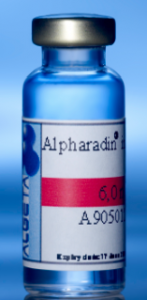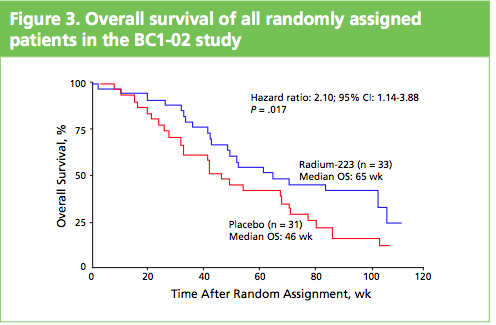Alpharadin Prostate Cancer data will be “Practice Changing” #EMCC2011
Radium-223 (Alpharadin) will be “Practice Changing” is how Michael Baumann, President of the European CanCer Organisation (ECCO) and Jean-Charles Soria, Co-Scientific chair of the 2011 Stockholm Multidisciplinary Cancer Congress described the prostate cancer clinical trial data to be presented in the Presidential (plenary) session on Saturday September 24, 2011.
Alpharadin is the first bone targeted therapy to show an overall survival (OS) advantage in metastatic castration-resistant prostate cancer (mCRPC). To date, none of the other therapies targeting bone in prostate cancer such as zoledronic acid (Zometa), denosumab (Xgeva) or cabozantinib (XL184) have shown any overall survival benefit.
The Alphardin data from the phase 3 ALSYMPCA trial that will be presented in Stockholm shows an increase in overall survival of 2.8 months compared to placebo (median OS of 14 months with Alpharadin versus median OS of 11.2 months with placebo, p=0.00185, HR=0.695).
What is big news is that Alpharadin also significantly prolongs time to first skeletal related event (p=0.00046; HR=0.610). This is tremendous news for prostate cancer patients given the number that experience bone metastases.
It is not, however, good news for Amgen and denosumab (Xgeva). Amgen have tried to associate the improvement in symptoms and decline in skeletal related events with survival, but have failed to obtain any overall survival data (OS). This is something that Alphardin achieves as well as a significant reduction in time to first skeletal related event (SRE).
What Alpharadin has effectively shown is that by nuking bone metastases using a weak alpha emitting radium-223, overall survival (OS) can be prolonged in a way that targeting rank ligand does not. This is ground breaking news and the 2011 Stockholm Multidisciplinary Congress have rightly recognized the importance of this data with a plenary session. For further information on how Alpharadin works – see my previous blog post about the ASCO 2011 phase 2 data.
 At the press briefing late friday afternoon in Stockholm, Dr Chris Parker of the Royal Marsden Hospital and PI of the ALSYMPCA study said that “Radium-223, a novel alpha-pharmaceutical, may provide a new standard of care for the treatment of CRPC patients with bone metastases.”
At the press briefing late friday afternoon in Stockholm, Dr Chris Parker of the Royal Marsden Hospital and PI of the ALSYMPCA study said that “Radium-223, a novel alpha-pharmaceutical, may provide a new standard of care for the treatment of CRPC patients with bone metastases.”
There is no doubt in my mind that it will lead to a new standard of care. What’s more as Dr Parker speculated in the press briefing, there is no reason why Alphardin could not be combined with androgen receptor antagonists such as the recently approved abiraterone acetate (Zytiga).
Both are well tolerated and operate by different mechanisms of action. It’s hard not to believe that the overall survival of CRPC patients will be increased by such a combination.
When approved, Alpharadin and any possible combination with Zytiga, may further delay the use of sanofi-aventis’ cabazitaxel (Jevtana) in the post-doctaxel CRPC setting. It may also potentially have an impact on the use of sipuleucel-T (Provenge) in the asymptomatic population.
The Alpharadin phase 3 trial results is exciting news from the 2011 Stockholm Multidisciplinary Cancer Congress. I will be writing more after Dr Parker presents the data in the Presidential session later today.


 The market for prostate cancer therapies is set to expand from $1 billion currently to $5 billion by 2015, according to analysts reported by
The market for prostate cancer therapies is set to expand from $1 billion currently to $5 billion by 2015, according to analysts reported by  There is a lot of focus at the
There is a lot of focus at the 
